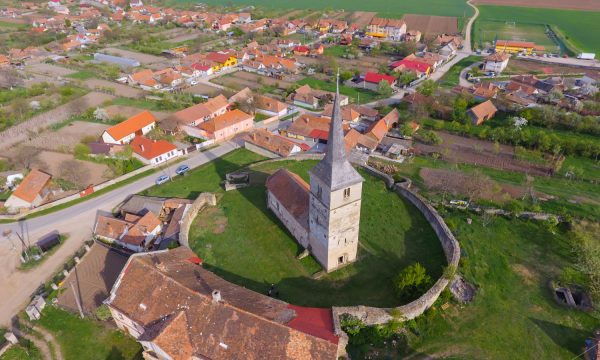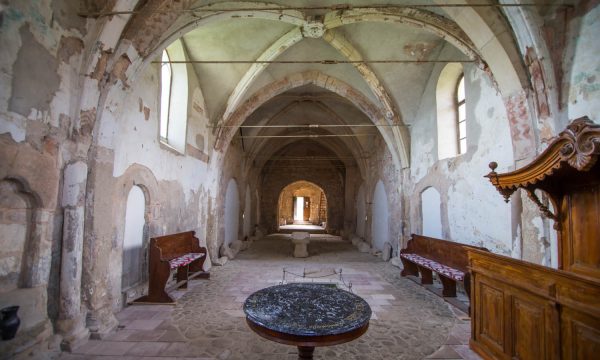Wall painting
The mass and spatial structure of the church, which was deprived of its aisles and was built, according to recent research, at the beginning of the 13th century, followed the Romanesque Saxon basilicas in Southern Transylvania (similar to Vințu de Jos – Hu: Alvinc – and Teiuș – Hu: Tövis – in the area); it had the layout of a basilica with a central nave, a polygonal choir on the eastern side and a tall tower standing at the west end. The side façades of the building are defined by the walled-up arcades that separated the former side aisles from the central area and the ogival arched moulding decorating the nave.

The western main portal with intrados is a nice piece of Romanesque art (the inscription 1684 only indicates a later repair). Once a gallery opened towards the nave on the first floor of the tower, which was then demolished in the Middle Ages to make way for a lower vaulting of the nave in the 15th century. The original, early Gothic vault of the choir is still standing today.

Inside the church there is a rich, not very known medieval painting, at least three consecutive layers of which were cut through by the subsequent vaulting of the nave. The so-called Italo-Byzantine scene of the Last Supper and the angels of the choir from the early 14th century belong to the last style layer. Since in today’s accepted chronology of the Transylvanian mural paintings this style is considered to be the earliest continuous stylistic language, it is surprising to the experts as well that several scenes belonging to very different styles appear under the Italo-Byzantine layer (including the figure of Saint Christopher and the fragment of the Last Judgment). In this second layer, several details can be discovered from the cycle of the legend of St. Ladislaus. Its best preserved elements are the scene of the Chase and the hooves of the horses from the previous scene belonging to the Battle scene. Comparing the stratification and the contemporary classification of the murals in chronological order, the cycle of the legend of St. Ladislaus in Cricău was created at the earliest in the first decades of the 14th century, possibly around the 1300s. This means that the mural cycle in Cricău is Transylvania’s oldest relic of this kind and one of the earliest occurrences of this subject in Hungary.

More recently it has become more and more accepted that the mural cycles depicting the legend of St. Ladislaus spread in the age of the Anjou kings, since it was very important for the new dynasty to respect St. Ladislaus, fostering thus the cult surrounding their predecessor on the Hungarian throne. Based on these, we believe that the mural in Cricău dates back to the 1310–20s.
Natural heritage
At the feet of the Trascău Mountains (Hu: Torockói-hegység), in the southern part of the Apuseni Mountains (Hu: Erdélyi-középhegység), there is a village of some 1200–1300 people, Cricău. This part of the Trascău Mountains became part of the Natura 2000 nature protection program for the preservation of its protected bird species. There are many hardwood forests in the area, spotted with meadows and pastures, which provide excellent hunting grounds for birds of prey, too.
One globally protected species found here is the corn crake (Crex crex), the grating voice of which can often be heard at night. It nests in the tall grass, and can only rarely be glimpsed because of its camouflaging colour and hiding nature, only taking flight as a last resort. The disappearance of the wet meadows, the agricultural burning of its habitats, over- or undergrazing, and the destruction of its nests by mowing all contributed to its endangerment. The local farmers take note of the corn crake mainly because if it is present on their lands they must not cut the grass on them until the end of July, and only with hand tools even then. However, they are compensated by the European Union for this. Although this measure does not solve the question of the corn crake’s protection entirely, it is a step in the right direction.
Nine more species protected on the EU level live in these parts: the golden eagle (Aquila chrysaetos), the white-backed woodpecker (Dendrocopos leucotos), the grey-headed woodpecker (Picus canus), the black woodpecker (Dendrocopos martius), the collared flycatcher (Ficedula albicollis), the woodlark (Lullula arborea), the European honey buzzard (Pernis apivorus), the Eurasian eagle-owl (Bubo bubo), and the peregrine falcon (Falco peregrinus).
One of Europe’s rarest bat species, the common bent-wing bat (Miniopterus schreibersii) can also be found here.
